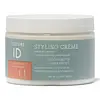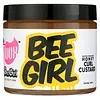What's inside
What's inside
 Key Ingredients
Key Ingredients

 Benefits
Benefits

 Concerns
Concerns

 Ingredients Side-by-side
Ingredients Side-by-side

Water
Skin ConditioningCarthamus Tinctorius Seed Oil
MaskingGlycerin
HumectantCocos Nucifera Oil
MaskingPhenoxyethanol
PreservativeAcrylates/C10-30 Alkyl Acrylate Crosspolymer
Emulsion StabilisingAloe Barbadensis Leaf Juice
Skin ConditioningCetearyl Alcohol
EmollientParfum
MaskingAminomethyl Propanol
BufferingPvp
Emulsion StabilisingPEG-40 Stearate
EmulsifyingPEG-20 Hydrogenated Lanolin
EmollientPEG-150 Stearate
Honey
HumectantEthylhexylglycerin
Skin ConditioningCetyl Alcohol
EmollientCeteareth-20
CleansingBenzoic Acid
MaskingGlycereth-2 Cocoate
EmulsifyingSodium Cetearyl Sulfate
CleansingPolysorbate 60
EmulsifyingHydrolyzed Wheat Protein
Skin ConditioningTocopheryl Acetate
AntioxidantButyrospermum Parkii Butter
Skin ConditioningTheobroma Cacao Seed Butter
EmollientWater, Carthamus Tinctorius Seed Oil, Glycerin, Cocos Nucifera Oil, Phenoxyethanol, Acrylates/C10-30 Alkyl Acrylate Crosspolymer, Aloe Barbadensis Leaf Juice, Cetearyl Alcohol, Parfum, Aminomethyl Propanol, Pvp, PEG-40 Stearate, PEG-20 Hydrogenated Lanolin, PEG-150 Stearate, Honey, Ethylhexylglycerin, Cetyl Alcohol, Ceteareth-20, Benzoic Acid, Glycereth-2 Cocoate, Sodium Cetearyl Sulfate, Polysorbate 60, Hydrolyzed Wheat Protein, Tocopheryl Acetate, Butyrospermum Parkii Butter, Theobroma Cacao Seed Butter
Water
Skin ConditioningPropanediol
SolventMaltodextrin/Vp Copolymer
Pvp
Emulsion StabilisingPolysorbate 20
EmulsifyingAminomethyl Propanol
BufferingAcrylates Copolymer
Aloe Barbadensis Leaf Juice
Skin ConditioningHydroxypropyltrimonium Honey
Keratin Amino Acids
Skin ConditioningSilk Amino Acids
HumectantPhenoxyethanol
PreservativeCarbomer
Emulsion StabilisingSorbitol
HumectantEthylhexylglycerin
Skin ConditioningSodium Lauryl Sulfate
CleansingSodium Hyaluronate
HumectantTocopheryl Acetate
AntioxidantHoney
HumectantPanthenol
Skin ConditioningAcrylates/C10-30 Alkyl Acrylate Crosspolymer
Emulsion StabilisingAscorbic Acid
AntioxidantButylene Glycol
HumectantSorbic Acid
PreservativeCoumarin
PerfumingCaramel
Cosmetic ColorantParfum
MaskingWater, Propanediol, Maltodextrin/Vp Copolymer, Pvp, Polysorbate 20, Aminomethyl Propanol, Acrylates Copolymer, Aloe Barbadensis Leaf Juice, Hydroxypropyltrimonium Honey, Keratin Amino Acids, Silk Amino Acids, Phenoxyethanol, Carbomer, Sorbitol, Ethylhexylglycerin, Sodium Lauryl Sulfate, Sodium Hyaluronate, Tocopheryl Acetate, Honey, Panthenol, Acrylates/C10-30 Alkyl Acrylate Crosspolymer, Ascorbic Acid, Butylene Glycol, Sorbic Acid, Coumarin, Caramel, Parfum
Ingredients Explained
These ingredients are found in both products.
Ingredients higher up in an ingredient list are typically present in a larger amount.
Acrylates/C10-30 Alkyl Acrylate Crosspolymer is a synthetic polymer. It is used to thicken and improve the texture of products. Due to its properties, it can prevent water and oil ingredients from separating.
Aloe Barbadensis Leaf Juice comes from leaves of the aloe plant. Aloe Barbadensis Leaf Juice is best known for helping to soothe sunburns. It is also anti-inflammatory, moisturizing, antiseptic, and can help heal wounds.
Aloe is packed with good stuff including Vitamins A, C, and E. These vitamins are antioxidants, which help fight free-radicals and the damage they may cause. Free-radicals are molecules that may damage your skin cells, such as pollution.
Aloe Barbadensis Leaf Juice also contains sugars. These sugars come in the form of monosaccharides and polysaccharides, folic acid, and choline. These sugars are able to help bind moisture to skin.
It also contains minerals such as calcium, 12 anthraquinones, fatty acids, amino acids, and Vitamin B12.
Learn more about Aloe Barbadensis Leaf JuiceAminomethyl Propanol is used to adjust the pH of products. It is also used as a base to create other organic compounds. Having a balanced pH is important for protecting your skin.
Aminomethyl propanol is safe to use in cosmetics up to 1%. It is soluble in water.
Ethylhexylglycerin (we can't pronounce this either) is commonly used as a preservative and skin softener. It is derived from glyceryl.
You might see Ethylhexylglycerin often paired with other preservatives such as phenoxyethanol. Ethylhexylglycerin has been found to increase the effectiveness of these other preservatives.
Honey comes from bees. It is mainly made up of the sugars fructose and glucose.
Besides sugar, honey also contains amino acids, peptides, Vitamins A, C, and E. Vitamins A, C, and E.
As a humectant, honey is great at hydrating the skin. Humectants draw moisture from the air and hold it to your skin.
Honey also has antioxidant and antioxidant properties. Fun fact: darker honey has more antioxidants than light honey.
The antibacterial property of honey may make it effective at helping to treat acne. We recommend speaking with a professional if you have concerns.
Many people wonder if honey is vegan. It is technically a byproduct from bees. This is because honey is created from the digestive enzymes in a bee's stomach.
Remember to be kind to bees :) They are important for many ecosystems and are endangered.
Learn more about HoneyParfum is a catch-all term for an ingredient or more that is used to give a scent to products.
Also called "fragrance", this ingredient can be a blend of hundreds of chemicals or plant oils. This means every product with "fragrance" or "parfum" in the ingredients list is a different mixture.
For instance, Habanolide is a proprietary trade name for a specific aroma chemical. When used as a fragrance ingredient in cosmetics, most aroma chemicals fall under the broad labeling category of “FRAGRANCE” or “PARFUM” according to EU and US regulations.
The term 'parfum' or 'fragrance' is not regulated in many countries. In many cases, it is up to the brand to define this term.
For instance, many brands choose to label themselves as "fragrance-free" because they are not using synthetic fragrances. However, their products may still contain ingredients such as essential oils that are considered a fragrance by INCI standards.
One example is Calendula flower extract. Calendula is an essential oil that still imparts a scent or 'fragrance'.
Depending on the blend, the ingredients in the mixture can cause allergies and sensitivities on the skin. Some ingredients that are known EU allergens include linalool and citronellol.
Parfum can also be used to mask or cover an unpleasant scent.
The bottom line is: not all fragrances/parfum/ingredients are created equally. If you are worried about fragrances, we recommend taking a closer look at an ingredient. And of course, we always recommend speaking with a professional.
Learn more about ParfumPhenoxyethanol is a preservative that has germicide, antimicrobial, and aromatic properties. Studies show that phenoxyethanol can prevent microbial growth. By itself, it has a scent that is similar to that of a rose.
It's often used in formulations along with Caprylyl Glycol to preserve the shelf life of products.
Pvp is a water-soluble synthetic polymer and common hairstyling ingredient. It is a film-forming ingredient and used to "hold" specific shapes of hair.
Pvp is less effective in high-humidity. It tends to draw moisture, but this moisture dismantles the structure and "hold".
Tocopheryl Acetate is AKA Vitamin E. It is an antioxidant and protects your skin from free radicals. Free radicals damage the skin by breaking down collagen.
One study found using Tocopheryl Acetate with Vitamin C decreased the number of sunburned cells.
Tocopheryl Acetate is commonly found in both skincare and dietary supplements.
Learn more about Tocopheryl AcetateWater. It's the most common cosmetic ingredient of all. You'll usually see it at the top of ingredient lists, meaning that it makes up the largest part of the product.
So why is it so popular? Water most often acts as a solvent - this means that it helps dissolve other ingredients into the formulation.
You'll also recognize water as that liquid we all need to stay alive. If you see this, drink a glass of water. Stay hydrated!
Learn more about Water